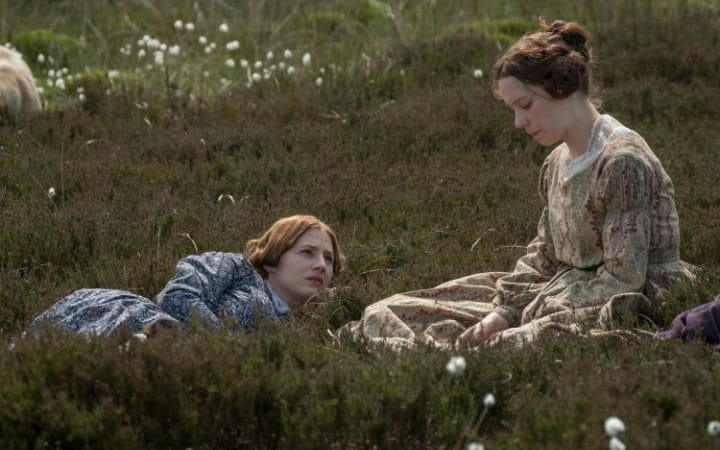On this day in 1818 a very special event was taking place in the parish church of Thornton, near Bradford in the West Riding of Yorkshire. It was the baptism of the fifth child of the parish curate Patrick and his wife Maria. In her lifetime this child was little known outside of her close, small circle of acquaintances but after her death she has become a legendary figure in the world of literature. She was Emily Brontë, and in today’s post we’re going to look at what we know about her baptism, and about her unusual choice of name.
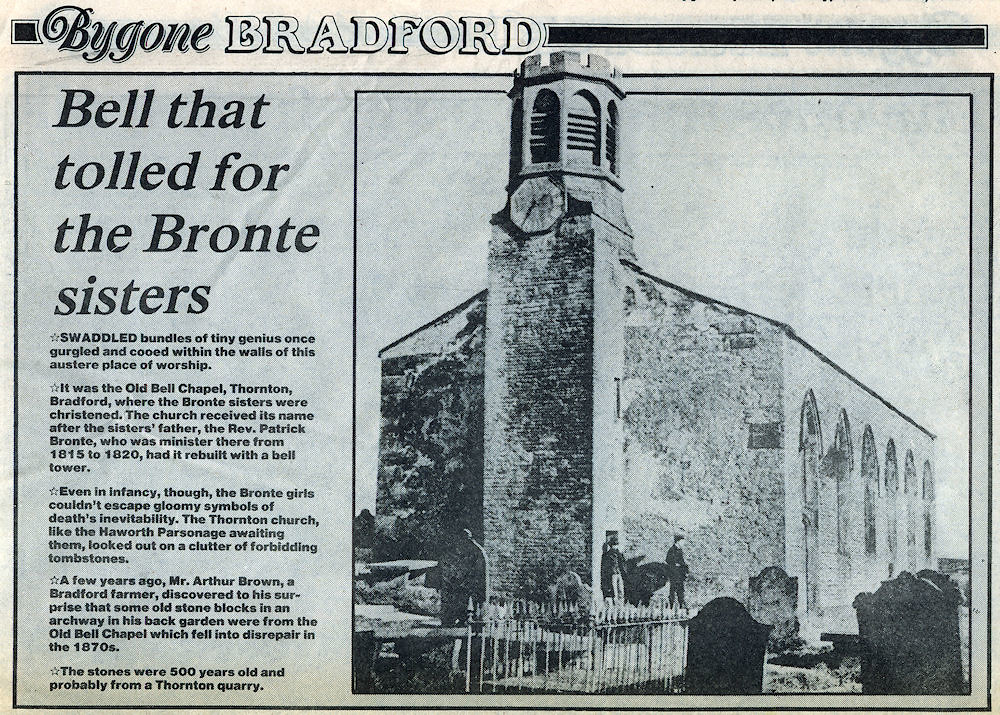
Emily had been born on the 30th July 1818, the fourth daughter of five children born to Patrick and Maria Brontë. At the time the parsonage building on Market Street must have been rather crowded, for not only did it contain Patrick and Maria and their children, Maria, Elizabeth, Charlotte, Patrick Branwell and now Emily Jane, it was also home to the two servant sisters Nancy and Sarah de Garrs. It was perhaps this overcrowding which led Patrick to write to the Bishop calling the building wholly inadequate to his needs – he was in search of a larger parish and a larger parsonage, but of course he would have to wait until the birth of his sixth child, Anne Brontë, before he could finally leave Thornton for the parish he and his family became synonymous with: Haworth.
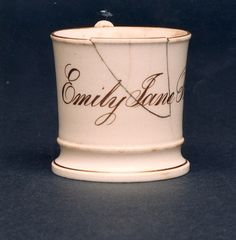
We have two fascinating items which capture a frozen moment in time, exactly 205 years ago today. One is the baptism cup shown above; bearing the name Emily Jane Brontë it is also cracked and repaired – perhaps it was knocked from a shelf, but it was such a prized possession that it was pieced back together again? Replicas of this delicate cup can now be bought, without the crack, from the Brontë Parsonage Museum shop, but the original is often on display in the parsonage itself.
The second item is below, and it’s the original baptism entry showing the baptism of Emily Jane Brontë. The information it gives is scant but interesting. On the 20th August 1818 the parish celebrated the baptism of Emily Jane, daughter of Patrick and Maria Brontë, A. B. (Patrick must have been proud of the degree he had earnt at Cambridge). The father’s profession is ‘Minister of Thornton’, and the presiding minister was William Morgan, Minister of Christ Church, Bradford.
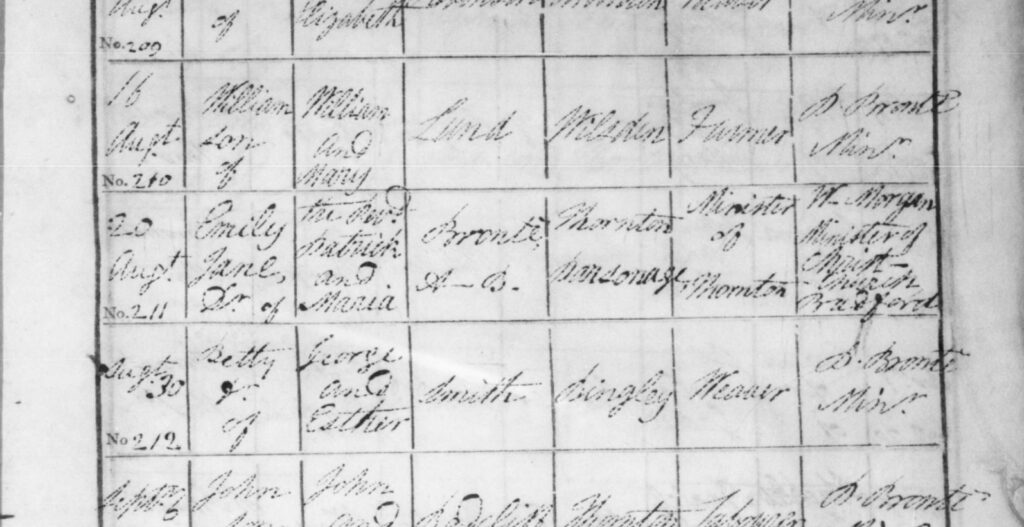
Welsh-born Morgan was a close friend of Patrick Brontë. They had first met when young curates in Shropshire, and their paths crossed again when Patrick moved to Yorkshire in 1812 – so close were they that they got married on the same day in a joint wedding ceremony in December of that year. We can safely say then that Reverend Morgan was very familiar with the Godmothers chosen for young Emily at that ceremony, for one was his wife and the other was his mother-in-law!
It was certainly a family affair in the Bell Chapel that day! As well as Patrick and Maria, and young Emily of course, and we can conjecture whether Emily’s siblings were there, there were Jane Morgan and Jane Fennell. Jane Fennel had originally been called Jane Branwell, and she was Maria Bronte’s aunt from Penzance in Cornwall. Jane Morgan was Jane Fennell’s daughter and therefore a cousin of Maria Brontë – she had married William Morgan at the same ceremony at which Patrick Brontë married Maria Branwell. The two priests acted as best men for each other, while the two brides were also chief bridesmaids. Phew, that’s a confusing paragraph to write or read on a Sunday. Also present in all likelihood would have been Elizabeth Firth of nearby Kipping House. It was Elizabeth who recorded the birth of Emily Jane Brontë in her diary, and a year and a half later it was her turn to be Godmother – to Anne Brontë.
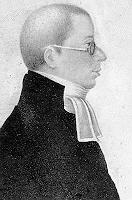
So it is clear why Emily Jane Brontë had the middle name she had – she was named after her mother’s Aunt Jane (or possibly her mother’s cousin Jane, or both). But now we come to the mystery of Emily’s name.
From Elizabeth Firth’s diary, we know that the child’s name had already been decided on the day of her birth, but even in the choice of name Emily differs from her other siblings, just as she was to prove to be different in many other ways as she grew into a strong willed, independent woman; a unique and powerful genius.
Emily Jane Brontë is the only Brontë daughter to be given a middle name, with, as we have seen, Jane presumably being chosen as a tribute to both Maria’s cousin and the aunt who had played a role in bringing her and her husband Patrick together. The choice of Emily for over two centuries remained a mystery, as there is no record of an Emily among either the Cornish or Irish relatives; this makes Emily the only Brontë not named after a parent, an aunt or an uncle. It seems fair to surmise that a woman named Emily must have been a friend known to Patrick and Maria, and a special one at that, whose name was given precedence over the Jane that would have been a more traditional choice in the family. I believe I may know who that friend was.
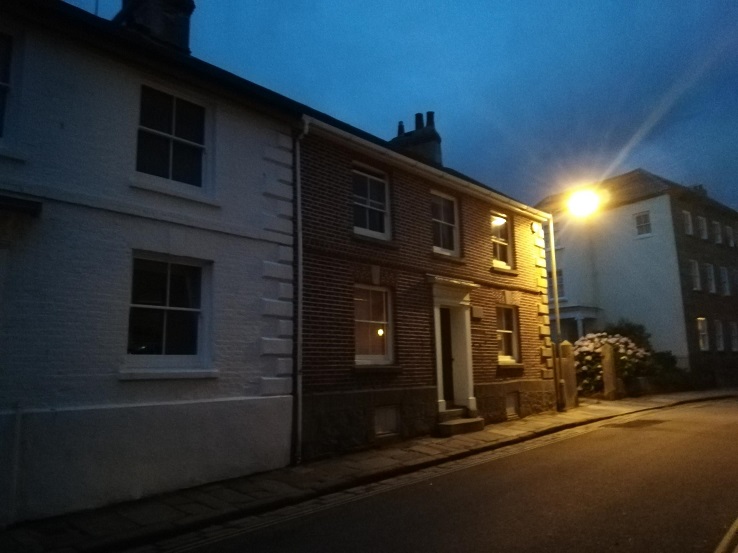
In the spring of 1817, Maria Brontë was pregnant, and her only son Patrick Branwell Brontë would soon be born. Maria’s sister Elizabeth Branwell had returned to Penzance but another visitor had taken her place in the busy parsonage on Thornton’s Market Street. On 18 March of that year, Elizabeth Firth’s diary records that ‘Miss Thomas came to Mr Brontë’s’, and we see records of her visits alongside Patrick and Maria in the diary until 18 May, when mention of her abruptly stops.
It is shown then that Miss Thomas stayed with the Brontës for at least two months, and such an extended visit shows that she must have been very close to Patrick or Maria, and it also suggests that, like Elizabeth Branwell the previous year, she must have travelled a long distance to get there and that the visit isn’t one that could be repeated regularly. Juliet Barker, in her excellent biography of the Brontë family, suggests that Miss Thomas could be a family member, or a friend that had travelled from Hartshead or Penzance.
After consulting the family tree we can say with certainty that there are no Branwell family relatives by the name of Thomas, but there is an intriguing entry in the 1851 census of Penzance. Here we find a visitor at 6, North Parade, the home of Guillaume Thomazie, a Professor of French and Italian – aged 74 she is named Emmy Thomas, unmarried and listed as a ‘former servant’. The 1861 census shows her still travelling at the age of 87 (the ages in nineteenth century census returns can often jump around in this way) when she is in Newlyn, Cornwall and listed as a ‘retired housekeeper.’
The Branwells were a family of some wealth and status in Penzance, and would doubtless have had a number of servants including, at the head of them all, a housekeeper. Could it be that this Miss Thomas was once the head of the Branwell family household and that, being less than ten years older than Maria, she had formed a close friendship with her? Furthermore, Emmy was often used for people christened Emily, so could we finally have a plausible source of the name given to the fifth Brontë child in 1818? Emily Brontë is the only sibling not named after a relative, but could she instead be named after a loyal friend who had journeyed from Cornwall to Thornton at a time when the Brontë family was growing?
I think so, and I hope to see you next Sunday for another new Brontë blog post. Now you must excuse me, I’m off to watch the Lionesses hopefully lift the World Cup for England!
